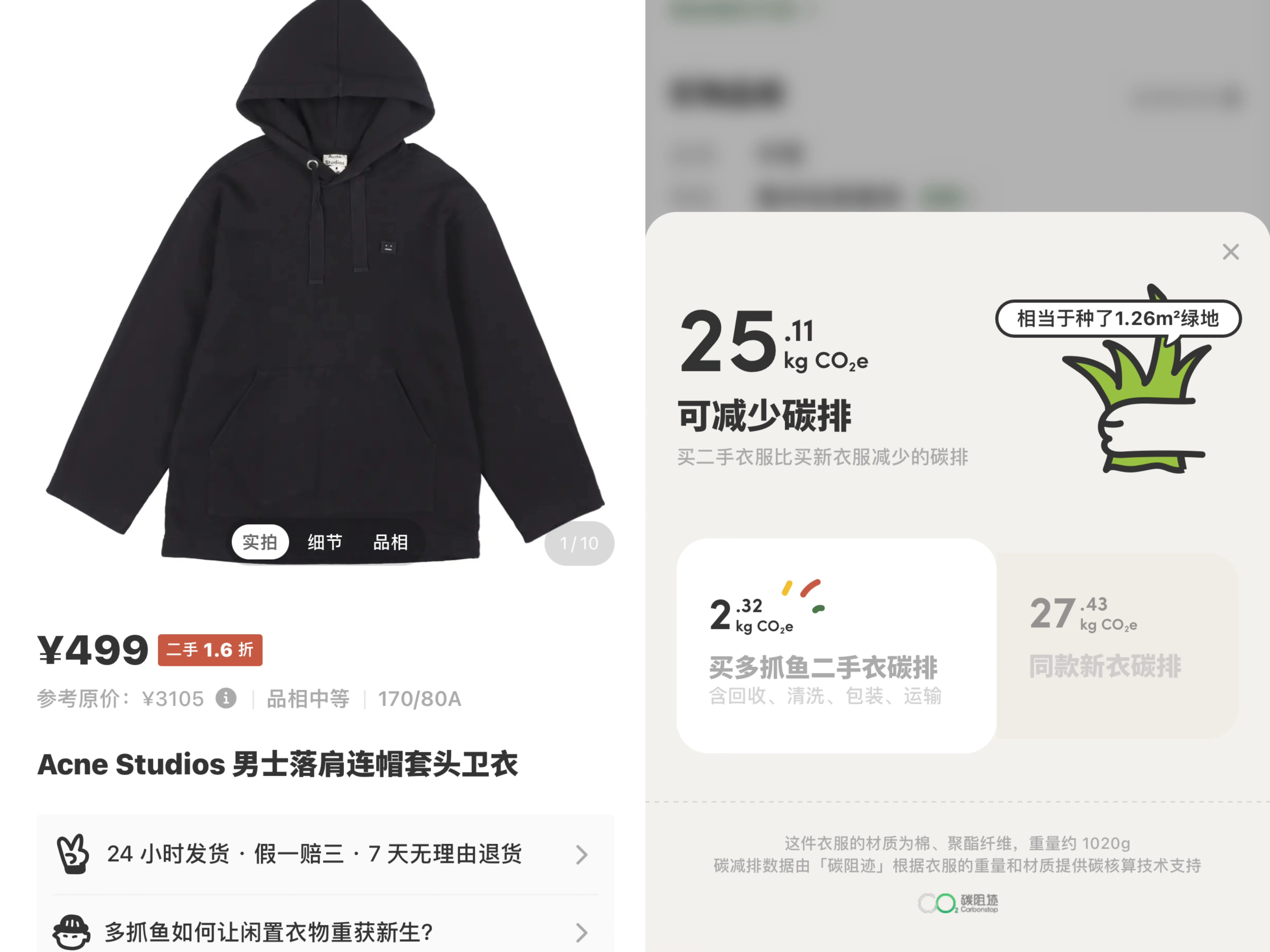The two platforms work together to quantify carbon emission reduction in recycled goods
How much carbon emissions can you reduce by purchasing a second-hand hooded hoodie? The answer is 25.11 kg CO2e。What is this concept? It's equivalent to planting 1.26m.2green space.
Recently, the second-hand trading platform has joined hands with carbon blocking to conduct in-depth carbon emission reduction calculations on the second-hand clothing trading scenarios on the platform. It aims to reveal the environmental protection value of second-hand clothing trading through specific data and guide consumers to actively participate in green consumption and jointly promote resource recycling and environmental protection.

Different materials for clothes have different unit emission reductions
So how is this specific string of data calculated?
Carbonstop said that due to the wide variety of clothes, complex and diverse fabrics, and various uncertainties in the production process, it is difficult to achieve accurate emission reduction accounting. Therefore, common similar projects such as used clothes recycling often use a unified average or estimate when calculating emission reductions.
It is understood that clothes made of different materials often correspond to different unit emission reductions. In order to achieve precise emission reduction of each type of clothing, Carbon Stop collects the emissions generated by multi-catch second-hand recycled clothing in multiple aspects such as recycling, disposal, sales, and transportation, and calculates the corresponding emissions generated by the second-hand clothing it sells.
Through the proportion of fabric used and clothing weight data of each piece of clothing, and connecting it with carbon cloud software, the emissions generated by recycling each piece of second-hand clothing on the multi-fish-catching platform are accurately calculated, compared with the carbon emission reduction value achieved by sales of new clothes under the same conditions.
Take a pair of jeans weighing about 0.55kg as an example. The material consists of 74% cotton, 15% polyester fiber and 11% polyurethane. Different materials have corresponding unit emission reductions. For example: the emission reduction per unit of cotton material is 25.98kg CO2e/kg, polyester fiber unit emission reduction is 19.15 kg CO2e/kg, polyurethane emission reduction per unit is 17.61kg CO2e/kg, the total emission reduction of this pair of jeans is (74%×25.98+15%×19.15+11%×17.61) ×0.55≈13.22kgCO2e。
The calculation of this data not only visually demonstrates the huge potential of second-hand clothing trading in reducing carbon emissions, but also helps to further confirm the positive impact of green recycling consumption models on climate change.
Use a transparent digital feedback mechanism to enhance users 'sense of environmental participation and accomplishment
According to data released by the International Energy Agency (IEA), the total carbon emissions of the textile and garment industry account for 10% of the global total emissions and are the second largest source of pollution after the oil industry. For every ton of textile products produced, 200 tons of water will be polluted, and for every kilogram of cloth produced, 23 kilograms of carbon dioxide gas will be emitted.
my country is the world's largest textile producer. According to the "Action Outline for Building a Modern Textile Industrial System" issued by the China Textile Industry Federation,(2022-2035)"shows that in 2022, the total fiber processing volume in the entire industry will exceed 60 million tons, accounting for more than 50% of the world; chemical fiber output will account for more than 70% of the world; textiles and apparel exports will total US$340.95 billion, accounting for more than one-third of the world's total.
In my country, the annual production of waste textiles exceeds 25 million tons, but the resource recovery rate is only 15%.
The emergence of second-hand clothes trading platforms such as catching fish has not only injected a new green trend into the fashion world, but also deeply implemented the "5R principles" in the field of environmental protection (i.e. Recycling, Reusing, Repairing, Reducing reduction, Reimagine reduction). As a recycling store, Duoyu hopes to promote the recycling of high-quality clothing, books and consumer durables, and reduce the burden on the earth caused by excessive production and consumption.
The reporter learned that a number of energy-saving and environmentally friendly designs have also been adopted in the Kunshan factory that catches more fish. Such as using environmentally friendly detergents, using petroleum (hydrocarbon) solvents, etc.,Some "heat energy recovery" pipes have also been designed to recycle residual heat energy to heat laundry water and reduce energy waste.
This time, the cooperation between catching more fish and carbon blocking allows consumers to intuitively understand the emission reduction effects they have achieved while participating in the second-hand clothing trading through scientific calculations and detailed data display. This kind of transparent feedback mechanism greatly enhances users 'sense of environmental participation and accomplishment.Pass this green belief on to the next person through recycled items.







